Content from the Brookings Doha Center is now archived. In September 2021, after 14 years of impactful partnership, Brookings and the Brookings Doha Center announced that they were ending their affiliation. The Brookings Doha Center is now the Middle East Council on Global Affairs, a separate public policy institution based in Qatar.
President Trump’s announcement that the United States will end its military presence in Syria “very soon” represents a significant departure from the administration’s previous position that the United States will maintain its deployment indefinitely. Currently, there are an estimated 2,000 U.S. troops operating in eastern Syria, most of them working alongside the Syrian Democratic Forces (SDF), the Kurdish-led umbrella force that has liberated the country’s eastern provinces from ISIS. Withdrawing from Syria right now would be reckless. Despite Trump’s reluctance, the United States has a much greater role to play that can prevent a resurgence of ISIS, push back against Iranian expansionism, and ensure the country is not engulfed in a state of perpetual warfare.
Nature abhors a vacuum
As the Iraq experience shows, withdrawals leave a void that can be filled by America’s enemies. Iran moved to capitalize on the space left by the withdrawal of U.S. troops in 2011. That proved to be critical to Iran’s dominance in Syria, as Iraq was a crucial transit point that reinforced the Assad regime with substantial arms and tens of thousands of powerful Iraqi Shiite militias who are now the most dominant force on the ground. It also resulted in the marginalization of Arab Sunnis and Kurds and intensified ethnic and sectarian tensions that arguably enabled the emergence of ISIS in 2014.
Withdrawing from Syria will hasten the resurgence of ISIS as Syria continues to live up to its status as the humanitarian calamity of the century and will be the scene of devastating conflict for years, if not decades, to come. Syrians’ collective consciousness has been shaped by almost a decade of war, and their past will almost certainly shape their future. The scars of war provide the structural conditions that allow groups like ISIS and their ilk to thrive. Meanwhile, it would be folly to assume a deal could be struck with Russia—not when it has been under its watch that ISIS established its “caliphate,” and not when under its protection the Assad regime has killed 400,000 civilians.
The Syrian civil war stopped being about the Syrian people a long time ago—it is now the battleground for the future of the Middle East regional order and the balance of power that comes with it. Powerful, transnational armed groups backed by outside actors have taken advantage of the breakdown of borders and the fragility of the Syrian state—and with devastating impact. They will continue to disrupt and destroy at will, at the behest of their international patrons.
Amid this dangerous mix, withdrawing from Syria will allow a Russia-dominated security architecture in the region and hasten the hegemony of Iran. While Iranian hegemony will be unacceptable throughout the region, other countries in the Middle East are too weak to effectively confront Iran without U.S. support and leadership. At best—and if left to fight on their own—America’s allies can sustain the proxy war but will only create a headache for Iran and Russia. They likely won’t alter the balance of power or change anything on the ground. In short, this is a recipe to keep Syria engulfed in a constant state of warfare.
A strategy for Washington
Alternatively, something of an equilibrium of power—recognizing that no single actor can achieve a decisive win in Syria—could help. This is where the United States steps in: It can impose and cultivate rules and limits for intervention and conflict. This will not happen overnight, granted, and requires not only continuing the U.S. presence in Syria but building on the current deployment of forces in the east of the country. In doing so—forcefully repelling Iranian and Russian attempts to test America’s resolve and force its personnel out of the country—the United States can emerge as the protector of a general stability. The goal would be to limit and contain the impact of conflict, while securing U.S. interests by suppressing the re-emergence of ISIS and Iranian expansionism.
At the very least, a sustained U.S. presence can ensure that some parts of Syria see some reprieve from conflict. Fundamentally, it will ensure that the territories east of the Euphrates don’t become a bastion for jihadi terrorists that threaten regional and international security and that the immense goodwill the United States has generated through its war on ISIS does not go to waste—and that it’s not co-opted by the Assad regime and its backers, Iran and Russia.
Moving forward, America’s dominance in eastern Syria could provide the launching pad for providing much-needed humanitarian assistance to the rest of the country but this would require a U.S. willingness to combat Iran’s proxies and other pro-regime groups that will attempt to upend such efforts. The expanded U.S. presence in the east could forestall the consolidation and increased entrenchment of Iran and its proxies, potentially even shift the balance of power away from these actors and their patrons.
The Untied States can go further still: It can lead a mediation effort between Turkey and the YPG, one that can build on Turkey’s newfound assertiveness in Syria, placate Turkish national security concerns by committing to restraining the YPG, and prevent Syrian Kurdistan from becoming a one-party, YPG-dominated statelet.
That will require a comprehensive political strategy that conditions U.S. support for the YPG on the group’s willingness to share power with its Kurdish rivals, as well as extending U.S. support for other Kurdish groups in Syrian Kurdistan. Building on the small window of opportunity that has emerged since Turkey took control of Afrin three weeks ago can harness Turkey’s regional standing and ensure that Washington does not go it alone. This approach also continues to use the YPG as a buffer against an ISIS resurgence and against increased Iranian expansionism.
U.S. efforts to mediate the Turkish-YPG conflict—as well as restore and normalize relations with Ankara—could even pave the way for a reworked quasi-version of the NATO-led International Security Assistance Force (ISAF) coalition in Afghanistan, one that includes Arab participation and a substantial Turkish contribution. For reasons of capacity, history, and ambition—and despite the recent deterioration in its relations with the West—Turkey is still the most viable regional partner in a war where the United States is not spoilt for choice. Turkish contributions to a containment effort in Syria would go a long way toward stabilizing the country, securing the interests of the United States and its allies, and helping to legitimize U.S. engagement in Syria.
The United States should certainly heed the lessons of the past by going in small and gradually. But it must also stand by its friends to secure common interests, including by building on the goodwill that has been won in ISIS-liberated areas. U.S. allies have done the bleeding and dying, and will continue working to bring urgent humanitarian assistance to beleaguered populations, to establish democratic norms and accountability, and to strengthen the resilience of Syria’s fragile society. They will have no hope if their fate is left to Iran and Russia, who will rejoice should the United States withdraw from Syria.
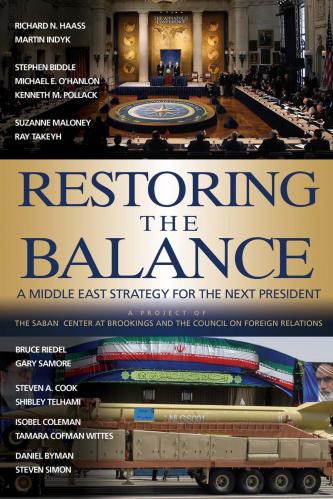
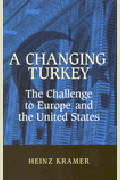
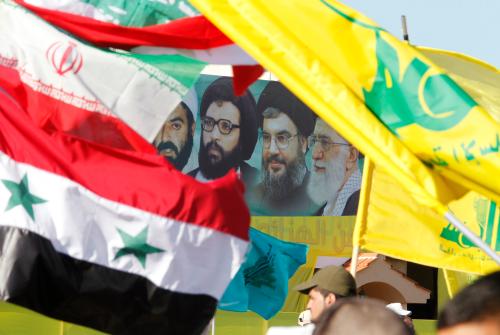
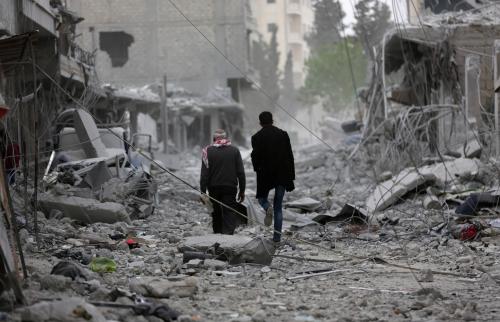
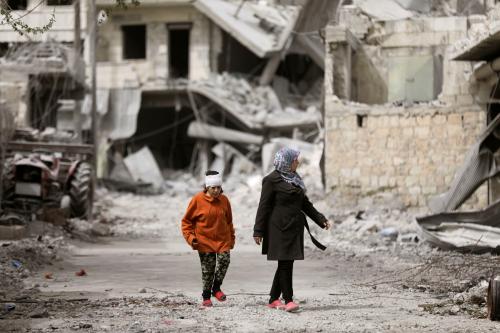


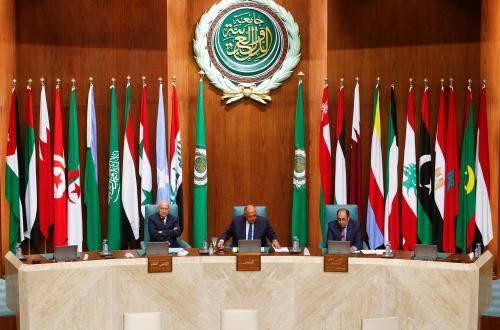
Commentary
How withdrawing from Syria would embolden Russia and Iran
April 5, 2018